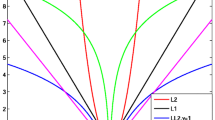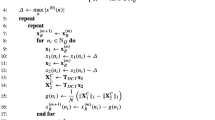Abstract
Sparse signals corrupted by impulsive disturbances are considered. The assumption about disturbances is that they degrade the original signal sparsity. No assumption about their statistical behavior or range of values is made. In the first part of the paper, it is assumed that some uncorrupted signal samples exist. A criterion for selection of corrupted signal samples is proposed. It is based on the analysis of the first step of a gradient-based iterative algorithm used in the signal reconstruction. An iterative extension of the original criterion is introduced to enhance its selection property. Based on this criterion, the corrupted signal samples are efficiently removed. Then, the compressive sensing theory-based reconstruction methods are used for signal recovery, along with an appropriately defined criterion to detect a full recovery event among different realizations. In the second part of the paper, a case when all signal samples are corrupted by an impulsive disturbance is considered as well. Based on the defined criterion, the most heavily corrupted samples are removed. The presented criterion and the reconstruction algorithm are applied on the signal with a Gaussian noise.











Similar content being viewed by others
References
M.S. Ahmad, O. Kukrer, A. Hocanin, Robust recursive inverse adaptive algorithm in impulsive noise. Circuits Syst. Signal Process. 31(2), 703–710 (2012)
R.G. Baraniuk. Compressive sensing. IEEE Signal Process. Mag. 24(4), 118–124 (2007)
T. Blumensath, Sampling and reconstructing signals from a union of linear subspaces. IEEE Trans. Inf. Theory 57(7), 4660–4671 (2011)
E.J. Candès, J. Romberg, T. Tao, Robust uncertainty principles: exact signal reconstruction from highly incomplete frequency information. IEEE Trans. Inf. Theory 52(2), 489–509 (2006)
E.J. Candès, T. Tao, Decoding by linear programming. IEEE Trans. Inf. Theory 51(12), 4203–4215 (2005)
E.J. Candès, T. Tao, Near-optimal signal recovery from random projections: universal encoding strategies? IEEE Trans. Inf. Theory 52(12), 5406–5425 (2006)
R.E. Carrillo, K.E. Barner, T.C. Aysal, Robust sampling and reconstruction methods for sparse signals in the presence of impulsive noise. IEEE J. Sel. Top. Signal Process. 4(2), 392–408 (2010)
F. Dadouchi, C. Gervaise, C. Ioana, J. Huillery, J.I. Mars, Automated segmentation of linear time-frequency representations of marine-mammal sounds. J. Acoust. Soc. Am. 134(3), 2546–2555 (2013)
I. Daubechies, M. Defrise, C. De Mol, An iterative thresholding algorithm for linear inverse problems with a sparsity constraint. Commun. Pure Appl. Math. 57(11), 1413–1457 (2004)
G. Davis, S. Mallat, M. Avellaneda, Adaptive greedy approximations. Constr. Approx. 13(1), 57–98 (1997)
I. Djurović, V.V. Lukin, M. Simeunović, B. Barkat, Quasi maximum likelihood estimator of polynomial phase signals for compressed sensed data. AEU Int. J. Electron. Commun. 68(7), 631–636 (2014)
D.L. Donoho, Compressed sensing. IEEE Trans. Inf. Theory 52(4), 1289–1306 (2006)
D.L. Donoho, M. Elad, V.N. Temlyakov, Stable recovery of sparse overcomplete representations in the presence of noise. IEEE Trans. Inf. Theory 52(1), 6–18 (2006)
M.J. Fadili, J.L. Starck, F. Murtagh, Inpainting and zooming using sparse representations. Comput. J. 52(1), 64–79 (2009)
M.A. Figueiredo, R.D. Nowak, S.J. Wright, Gradient projection for sparse reconstruction: application to compressed sensing and other inverse problems. IEEE J. Sel. Top. Signal Process. 1(4), 586–597 (2007)
P. Flandrin, P. Borgnat, Time-frequency energy distributions meet compressed sensing. IEEE Trans. Signal Process. 58(6), 2974–2982 (2010)
S.G. Mallat, Z. Zhang, Matching pursuits with time-frequency dictionaries. IEEE Trans. Signal Process. 41(12), 3397–3415 (1993)
J.J. Moré, G. Toraldo, On the solution of large quadratic programming problems with bound constraints. SIAM J. Optim. 1(1), 93–113 (1991)
D. Needell, J.A. Tropp, CoSaMP: iterative signal recovery from incomplete and inaccurate samples. Appl. Comput. Harmonic Anal. 26(3), 301–321 (2009)
Z.M. Ramadan, Efficient restoration method for images corrupted with impulse noise. Circuits Syst. Signal Process. 31(4), 1397–1406 (2012)
A.A. Roenko, V.V. Lukin, I. Djurović, Two approaches to adaptation of sample myriad to characteristics of S\(\alpha \)S distribution data. Signal Process. 90(7), 2113–2123 (2010)
E. Sejdić, A. Cam, L. Chaparro, C. Steele, T. Chau, Compressive sampling of swallowing accelerometry signals using time-frequency dictionaries based on modulated discrete prolate spheroidal sequences. EURASIP J. Adv. Signal Process. 101, 1–14 (2012)
T. Serafini, G. Zanghirati, L. Zanni, Gradient projection methods for quadratic programs and applications in training support vector machines. Optim. Methods Softw. 20(2–3), 353–378 (2005)
I. Stanković. Recovery of images with missing pixels using a gradient compressive sensing algorithm. arXiv preprint arXiv:1407.3695 (2014)
L. Stanković, A measure of some time–frequency distributions concentration. Signal Process. 81(3), 621–631 (2001)
L. Stanković, M. Daković, On the reconstruction of randomly sampled sparse signals using an adaptive gradient algorithm. arxiv:1412.0624
L. Stanković, M. Daković. On the uniqueness of the sparse signals reconstruction based on the missing samples variation analysis. Math. Probl. Eng. Article ID 629759 (2015). doi:10.1155/2015/629759
L. Stanković, M. Daković, S. Vujović, Adaptive variable step algorithm for missing samples recovery in sparse signals. IET Signal Process. 8(3), 246–256 (2014)
L. Stanković, Digital Signal Processing with Selected Topics (CreateSpace Independent Publishing Platform, An Amazon.com Company, North Charleston, 2015)
L. Stanković, I. Orović, S. Stanković, M.G. Amin, Compressive sensing based separation of nonstationary and stationary signals overlapping in time–frequency. IEEE Trans. Signal Process. 61(18), 4562–4572 (2013). doi:10.1109/TSP.2013.2271752
L. Stanković, S. Stanković, M.G. Amin, Missing samples analysis in signals for applications to L-estimation and compressive sensing. Signal Process. 94, 401–408 (2014)
L. Stanković, S. Stanković, I. Orović, M.G. Amin, Robust time-frequency analysis based on the L-estimation and compressive sensing. IEEE Signal Process. Lett. 20(5), 499–502 (2013)
C. Studer, P. Kuppinger, G. Pope, H. Bolcskei, Recovery of sparsely corrupted signals. IEEE Trans. Inf. Theory 58(5), 3115–3130 (2012)
B.A. Turlach, On algorithms for solving least squares problems under an L1 penalty or an L1 constraint. in 2004 Proceedings of the American Statistical Association, Statistical Computing Section [CD-ROM], pp. 2572–2577 (2005)
S.V. Vaseghi, Advanced Digital Signal Processing and Noise Reduction (Wiley, Hoboken, 2008)
S.J. Wright, Implementing proximal point methods for linear programming. J. Optim. Theory Appl. 65(3), 531–554 (1990)
G. You, T. Qiu, A. Song, Novel direction findings for cyclostationary signals in impulsive noise environments. Circuits Syst. Signal Process. 32(6), 2939–2956 (2013)
Author information
Authors and Affiliations
Corresponding author
Rights and permissions
About this article
Cite this article
Stanković, L., Daković, M. & Vujović, S. Reconstruction of Sparse Signals in Impulsive Disturbance Environments. Circuits Syst Signal Process 36, 767–794 (2017). https://doi.org/10.1007/s00034-016-0334-3
Received:
Revised:
Accepted:
Published:
Issue Date:
DOI: https://doi.org/10.1007/s00034-016-0334-3




